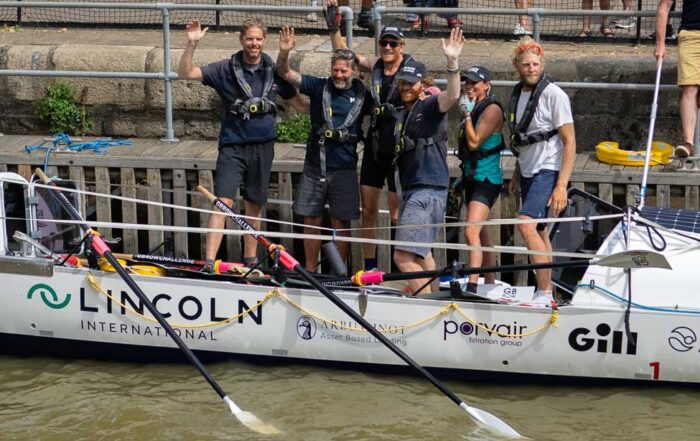The all-female crew rowing around Great Britain is over halfway around. Despite rough conditions in recent days, they rowed under the Skye Bridge this afternoon and have less than 1,000 miles to go.
‘Team Ithaca’ includes six extraordinary women taking part in the GB Row Challenge, a 2,000 mile row around Britain’s coastline. They’ve been rowing for the last 21 days and if they finish within 50, they’ll break a Guinness World record for the first female team of six to have ever completed the feat.
Skipper Emma Wolstenholme said: “We’re now in Scotland and the famous Corryvreckan marked the halfway point. We have been in constant rain and side winds creating side-on waves day and night, so although it’s awesome to be halfway, we are all very wet and hoping for some Scottish sunshine.”
The team have said that highs have included beautiful sunsets and sunrises, seeing dolphins, minke whales, puffins and shooting stars. Lows have included sleep deprivation, seasickness and rowing in torrential rain.
One of the rowers, Sandra Gates, said: “It feels great to be over halfway round. The highs for me are rowing with dolphins, being under the milky way and seeing shooting stars and sea sickness finally going! The whole experience is huge for me. I can’t wait to see Scotland from a different angle and appreciate our beautiful coastline while ticking the miles off and heading home. I’m not sure I will ever get used to the graveyard shift and I’m pretty sure I will never want to hear a mobile alarm for some time. I miss my family and dogs so much but I’m loving the experience.”
While rowing, they’re making an enormous contribution to an ocean pollution map of UK waters as they collect data on microplastics, temperature, noise pollution, and biodiversity.
So far they have collected 25 samples of Environmental DNA (eDNA) using an automatic pumping system, which will provide data on biodiversity.
Dr Kat Bruce, Founder Director of biodiversity company Naturemetrics, who completed the GB Row Challenge last year, said: “Animals are constantly shedding tiny traces into the environment – including dead skin cells, mucous, saliva, urine and faeces. These tiny traces contain the DNA of the animal, which means we can record hundreds of species without necessarily ever seeing them.
“The rowers are making this incredible journey around the coast and they’ll be awed by the beauty and diversity of this island we live on. When I rowed last year, we had many encounters with wildlife, including dolphins, porpoises, seals and seabird colonies.
“But most of the biodiversity is under the water and the rowers will have no idea what different species their data will capture! The eDNA from a single litre of water can reveal hundreds of species, from invertebrates to blue whales. It’s this vital data that is helping to build a picture of our nation’s precious biodiversity so that we can better protect it.”
The rowers are also collecting data on microplastics, thanks to an innovative collaboration between University of Portsmouth scientists and engineers from Harwin and Porvair Filtration Group.
Experts have worked together to design and build a microplastics sampling system, developed to both survive the harsh environment at sea and work around the limited physical space and power available on the boats.
The rowers have collected 14 samples of microplastics so far, building on the data collected during last year’s race, which will allow scientists to see any changes happening year on year.
Dr Fay Couceiro, expert in biogeochemistry and environmental pollution at the University of Portsmouth, said: “We’re so grateful to this amazing team of women who are rowing continuously, two hours on and two hours off in sun, strong winds and heavy rain.
“Their efforts are helping to produce an annual map of ocean pollution and biodiversity, which will give a clearer picture of the environmental damage and long term impact of these pollutants on our seas.”
Their boat ‘Challenger’ is also taking continuous recordings of underwater sound using an RS Aqua noise recorder integrated into the rudder. As well as collecting data on salinity and temperature.
Share This Story, Choose Your Platform!
Recent Posts
Study reveals how much UK seas have warmed in a year
UK seas were, on average, 0.39°C warmer in 2023 compared to 2022, a report by the University of Portsmouth and GB Row Challenge has found. Some regions, including the Celtic and Irish Seas and the northern North [...]
How Extreme Rowing Challenge Is Tackling Ocean Pollution
Tackling ocean pollution is one of the biggest environmental challenges of our time. Extreme rowing challenges are now playing a vital role in tackling ocean polluting by gathering valuable data, raising awareness, and inspiring action. [...]





